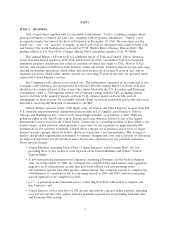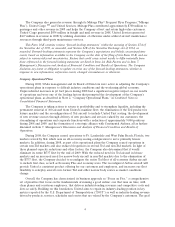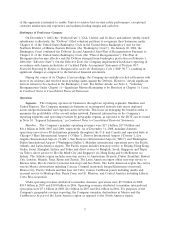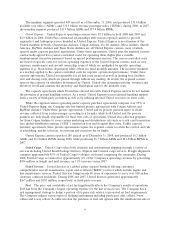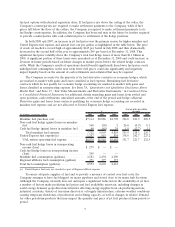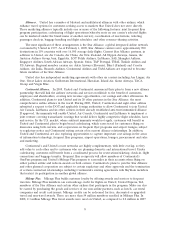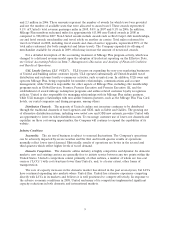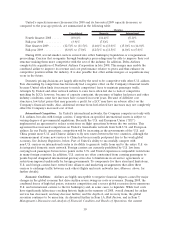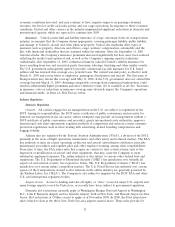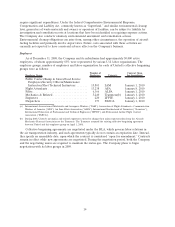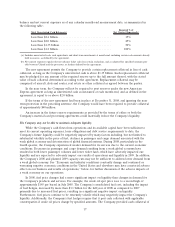United Airlines 2008 Annual Report Download - page 13
Download and view the complete annual report
Please find page 13 of the 2008 United Airlines annual report below. You can navigate through the pages in the report by either clicking on the pages listed below, or by using the keyword search tool below to find specific information within the annual report.Airport Access. Historically, access to foreign markets has been tightly controlled through bilateral
agreements between the U.S. and each foreign country involved. These agreements regulate the markets
served, the number of carriers allowed to serve each market and the frequency of carriers’ flights. Since
the early 1990s, the U.S. has pursued a policy of “open skies” (meaning all carriers have access to the
destination), under which the U.S. government has negotiated a number of bilateral agreements allowing
unrestricted access between U.S. and foreign markets. Additionally, all of the airports that United serves
in Europe and Asia maintain slot controls, and many of these are restrictive due to congestion at these
airports. London Heathrow, Frankfurt and Tokyo Narita are among the most restrictive due to capacity
limitations. United has significant operations at these locations.
United’s ability to serve some foreign markets and expand into certain others is limited by the
absence altogether of aviation agreements between the U.S. government and the relevant governments.
Shifts in U.S. or foreign government aviation policies can lead to the alteration or termination of air
service agreements. Depending on the nature of any such change, the value of United’s international
route authorities and slot rights may be materially enhanced or diminished.
The U.S./EU open skies agreement became effective in March 2008. This agreement replaced the
bilateral arrangements between the U.S. government and the 27 EU member states. Based on the
U.S. open skies model, it provides U.S. and EU carriers with expansive rights that have increased
competition in transatlantic markets. For example, U.S. and EU carriers now have the right to operate
between any point in the U.S. and the EU. The Agreement has no direct impact on airport slot rights
nor does it provide for a reallocation of existing slots, including those at London Heathrow. London
Heathrow currently remains subject to both slot and facility constraints.
The agreement provides United with additional commercial opportunities since it triggered the
effectiveness of United’s anti-trust immunity with British carrier bmi, creating the potential for increased
cooperation between the two carriers in the transatlantic market. The DOT had previously conditioned
the carriers’ immunity upon the entry into force of an open skies agreement with the U.K. and the U.S./
EU agreement satisfies this condition. Because of the diverse nature of potential impacts on United’s
business, however, the overall future impact of the U.S./EU agreement on United’s business cannot be
predicted with certainty.
Also in 2008, the EU adopted interpretive guidance and legislation that will impact the Company.
The Commission has officially sanctioned secondary slot trading, a current practice among carriers that
involves the sale, purchase or lease of slots. This action resolves disputes about the legality of slot
exchanges at EU airports including Heathrow. In addition, the EU has adopted legislation to include
aviation within the EU’s existing greenhouse gas emissions trading scheme effective in 2012. There are
significant questions that remain as to the legality of applying the scheme to non-EU airlines and the
U.S. and other governments are considering filing a legal challenge to the EU’s unilateral inclusion of
non-EU carriers. While such a measure could significantly increase the costs of carriers operating in the
EU, the precise cost to United is difficult to calculate with certainty due to a number of variables, and it
is not clear whether the scheme will withstand legal challenge.
Environmental Regulation.
The airline industry is subject to increasingly stringent federal, state, local and foreign
environmental laws and regulations concerning emissions to the air, discharges to surface and subsurface
waters, safe drinking water and the management of hazardous substances, oils and waste materials. New
regulations surrounding the emission of greenhouse gases (such as carbon dioxide) are being considered
for promulgation both internationally and within the United States. United is carefully evaluating the
potential impact of such proposed regulations. Other areas of developing regulations include the State of
California rule-makings regarding air emissions from ground support equipment and a federal
rule-making concerning the discharge of deicing fluid. The airline industry is also subject to other
environmental laws and regulations, including those that require the Company to remediate soil or
groundwater to meet certain objectives. Compliance with all environmental laws and regulations can
13


